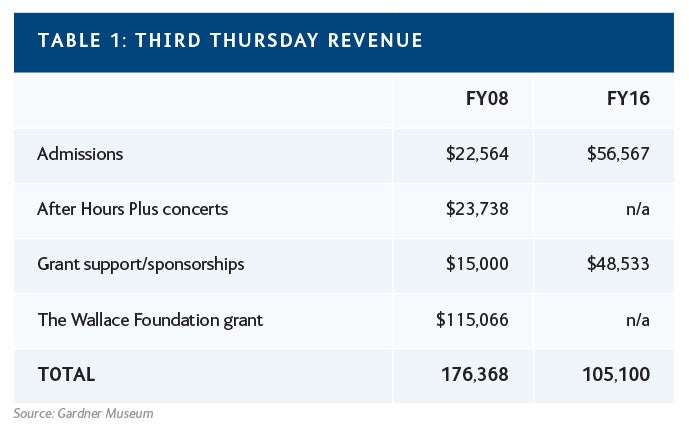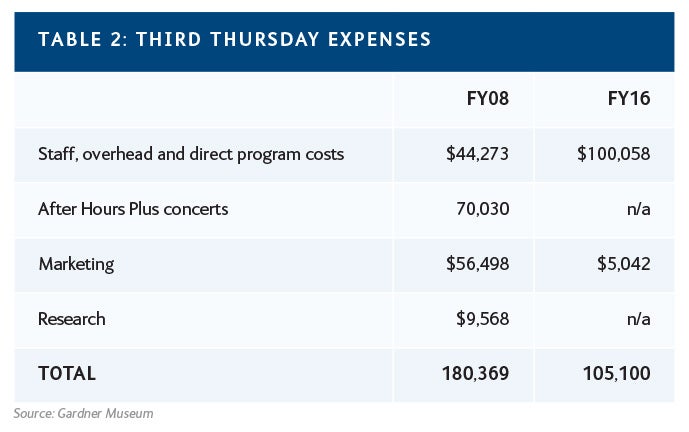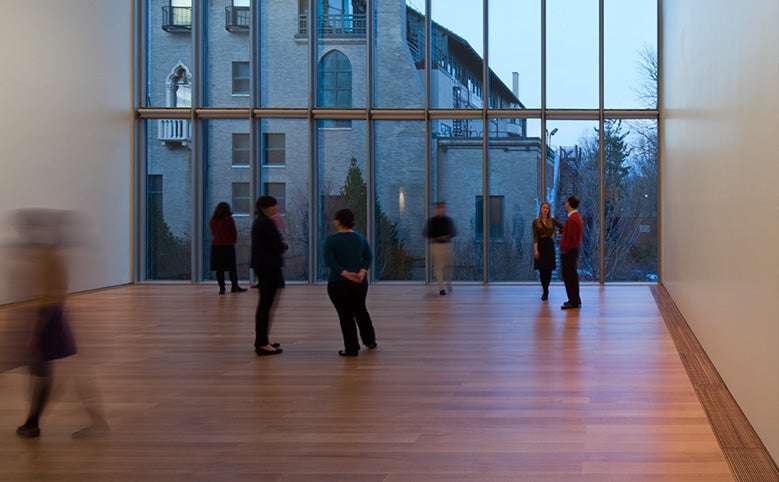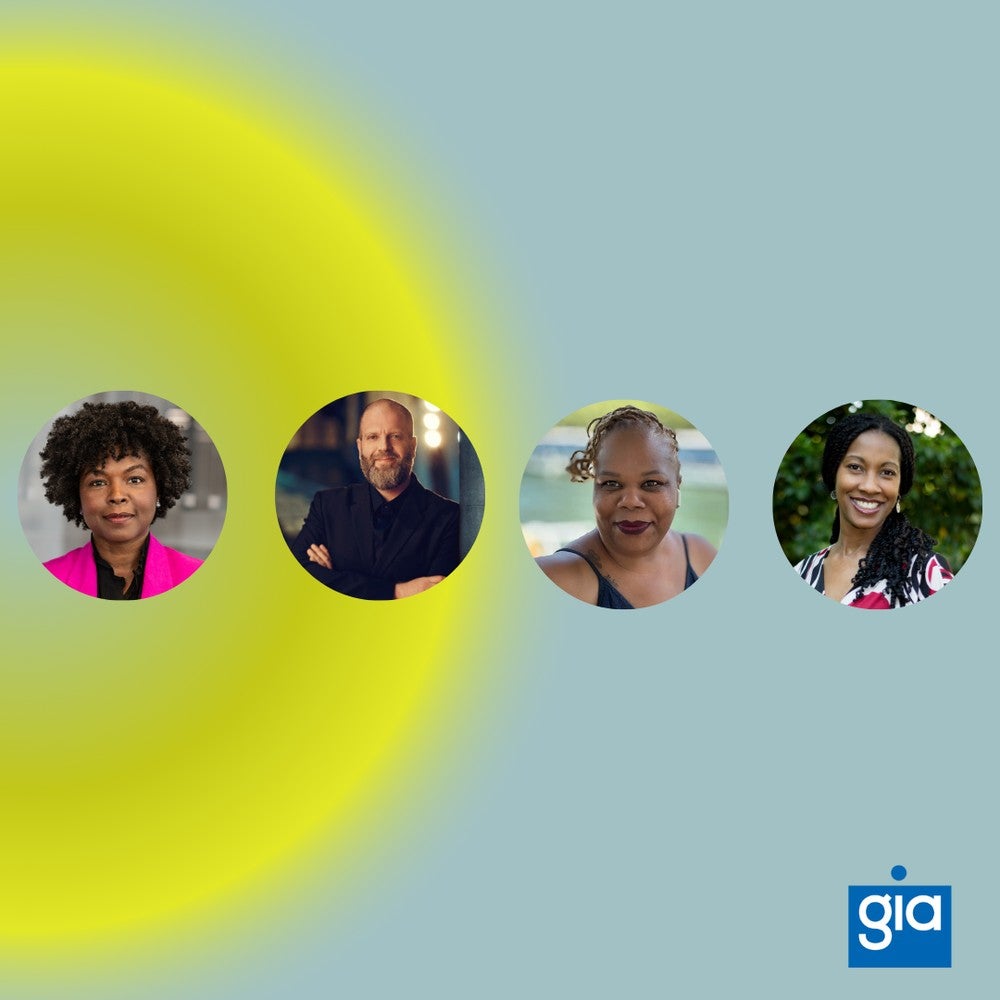In 2006, the Isabella Stewart Gardner Museum received a five-year Wallace Excellence Award to help it reach and engage a younger audience of millennials. This award was one of 54 grants The Wallace Foundation offered to arts organizations in six cities to help them use data and analysis to build audiences.
One Thursday evening last summer, with her drink in hand, Dana Riechman casually stood near an ornate pillar by the Isabella Stewart Gardner Museum’s magical garden courtyard. Riechman, 33, an administrator in MIT’s international students office, was flanked by two twenty-something Ph.D. candidates she had brought with her to the Venetian-style palazzo smack in the middle of Boston.
“I love it here,” Riechman said. She was referring both to the museum and the event she was attending, a monthly gathering initiated ten years ago to cultivate a younger following for the institution. “And every time, I walk around all the galleries, too.”
This event, called Third Thursdays, has become something of a Boston institution itself. From 5:30 p.m. to 9:00 p.m., an audience made up mostly of young professionals and students—the target audience for the event—shows up to listen to music, make art, hang out with friends and meet new people. All the while, it soaks up the pleasures of the eclectic collection, carefully amassed by the flamboyant art patron Isabella Stewart Gardner, who founded the institution at the turn of the 20th century. In fiscal year 2016, average monthly attendance was around 860 attendees, 75 percent of whom were in the target 18-to-34-year-old demographic (total attendance at the museum in fiscal year 2016 was over 256,000, with an average daily attendance of 830). What’s more, after a year-long hiatus in 2011 during the construction of a modern 70,000-square-foot addition, staff boosted attendance through new partnerships and a process of continuous improvement.
But Third Thursdays also has a stealth agenda: to acquaint a younger generation with the collection—which contains more than 6,000 fine and decorative works of art, 2,500 manuscripts and rare books, and 7,000 letters, photographs, and other memorabilia —and inspire them to engage enthusiastically with what they see. And as Riechman can testify, it’s worked. “This has been a fantastic way of introducing a large number of young people to the museum,” said Jessie Schlosser Smith (herself a millennial), who began her work as director of public programs in 2012.
The event was introduced in 2007 as a way to address a disturbing long-term trend facing museums and other arts organizations nationwide—declining attendance among younger adults. “Cultural organizations in general need to connect with younger people if they want to remain vibrant institutions,” said Smith. To ensure the steady involvement of a young audience, the staff came up with an idea: an evening gathering aimed at millennials that could take advantage of the museum’s romantic, moody, otherworldly atmosphere. With funding from a Wallace Excellence Awards grant, the staff dove headfirst into the effort.
The tricky part was finding a way to provide an experience that would attract a new millennial audience while also staying true to the museum’s mission. Isabella Stewart Gardner wanted to inspire visitors to engage deeply and directly with the art they saw, on both personal and communal levels. To that end, there are no labels with explanatory information adjacent to the works, allowing visitors to draw impressions first from their own observations. Gardner was so passionate about this approach to viewing art, she stipulated in her will that none of the works in her museum could be moved permanently.
Guided by Gardner’s vision, along with research revealing the target audience’s preference for social interaction, the staff introduced a variety of innovations, as reported in a 2011 case study published by The Wallace Foundation. Gallery games, for example, were fun challenges that generally involved looking for clues in the works of art, winning stickers and the like. To create a welcoming environment, where art novices wouldn’t feel too intimidated to ask questions, a crew of gregarious millennial-age volunteers, who knew the collection well, were stationed throughout the museum. Some also led 15-minute talks about select works of art in a particular gallery, inviting visitors to ask questions and making comments with friendly, open-ended queries. The effort was a success, with upwards of 700 visitors per evening in its third year. Perhaps more importantly, over 90 percent of visitors explored the galleries, and more than half said it was their favorite part of the evening.
A Second Incarnation
The current program is, in fact, the second incarnation of the event. Launched under the name of Gardner After Hours, the program was put on hold for a year while the museum constructed an addition. The new building was aimed at reducing the pressure on the fragile, original palace, as well as creating room for programming opportunities and exhibitions that couldn’t be housed in the older building. When the museum opened its doors again and the staff re-introduced the event with a different name, Third Thursdays, they didn’t need to develop the basic elements from scratch. But they did have to create a new following and rebuild the enthusiasm the program had inspired before. That feat was especially challenging thanks to the nature of Boston’s population, one-third of which is between the ages of 18 and 34, many of them highly transient students or recent graduates.
Just as it was when the program was launched initially, a young staff the same age as the target audience was empowered by Peggy Burchenal, who heads education and public programs, to take over and run the show. Burchenal recognized the secret to success lay in giving younger staff members considerable control over programming, marketing and even the budget. She believed that by doing so, the event would more likely be designed and promoted in a way that would draw others in their age group.
Making the Most of the New Space
In May 2012, when Smith came on board, she worked closely with the marketing and education departments to consider how best to incorporate the new addition into the event. The Renzo Piano building was designed to be an open, modern space distinctly different from the palace, and offered a plethora of resources the original facility lacked: a studio, a 300-seat performance space called Calderwood Hall and an informal area named the Living Room, as well as a special exhibition gallery. The main question the staff had to answer: How best to take advantage of all those assets in a way that added something enjoyable, engaging and appropriate to the evening?
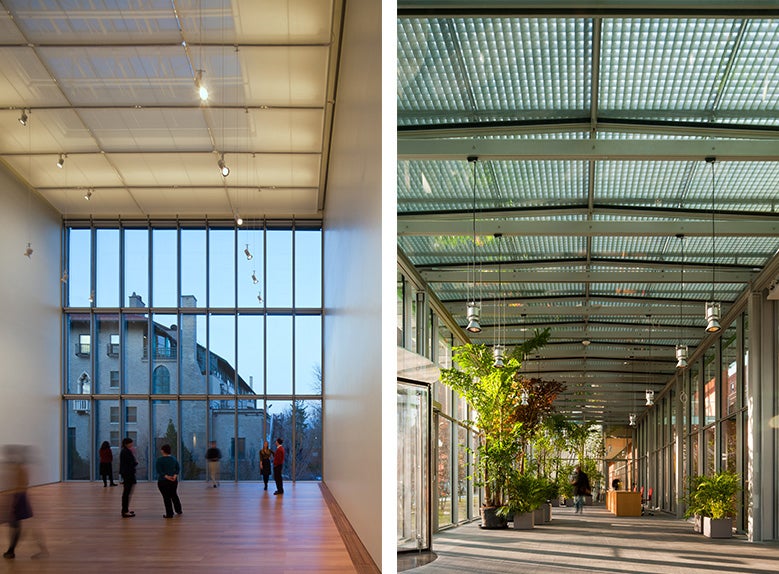
One answer was to form new partnerships with organizations that could complement the evening’s spirit and programming. The addition opened up an opportunity to work with other local groups able to offer new types of hands-on projects and performances at Third Thursdays. Plus, those organizations would attract the attention of their own following, many of whom were new to Third Thursdays and to the Gardner. “We’re able to co-create programming we couldn’t have done on our own and reach new audiences at the same time,” said Burchenal. In fact, according to Smith, attendance now tends to be especially high during times when the museum features activities organized through partnerships. And because the ever-curious Gardner was interested in a wide variety of creative disciplines ranging from modern dance to literature, identifying programming with an authentic connection to the museum’s mission and founder hasn't been difficult.
To that end, Smith’s major focus when she came on board was forming connections to organizations that would make effective partners. Initially, she contacted them. As word spread, they were approaching her, looking for ways to take advantage of their creative talents, while linking in a genuine way to the museum that, according to Smith, helps staff and visitors alike see the institution in a new way.
Gardner closely works with its partner organizations to create programming appropriate for both the museum’s mission and space. Take Urbanity Dance, a Boston-based contemporary and modern dance company that was featured at the March 2016 Third Thursdays evening. The programming included performances in Calderwood Hall, as well as in the courtyard, plus live figure drawing of dancers in the studio. But Urbanity didn’t simply recycle existing pieces. Instead, choreographer Betsi Graves worked with Gardner archivists to learn about Isabella Stewart Gardner’s involvement in dance and incorporate that information in their work.

We have a template that stays the same, but then there’s always something fresh.
The underlying framework for the evening: “We have a consistent template, but then there’s always something fresh,” said Burchenal. And there would be multiple elements specifically designed to appeal to millennials: spending social time with friends, while engaging in a variety of low-pressure, interactive activities with a distinctly DIY bent.
The team also kept some of the most-successful elements from the original Gardner After Hours, while adding or expanding others. “We’re always thinking about what makes sense for young adults,” said Smith. Gallery games, a big hit in earlier years, remained. They were not only popular, but effectively encouraged visitors to visit the galleries and engage vigorously with the art. At the same time, the staff re-introduced special themes for each evening. They would shape and connect the night’s activities, while also tying in authentically with Isabella Stewart Gardner’s interests and life. For example, one evening last summer, the team decided to focus on travel, a special love of Gardner’s. Thus, to connect to the theme, the evening’s gallery game was Art We There Yet?, a six-page “travel booklet” that visitors found on a table by the courtyard. It contained three “stops,” each featuring a photograph from Gardner’s extensive travel photo albums and clues to find a related work of art on display in the palace. Those who completed a booklet were eligible to enter a raffle for a $50 gift certificate to the museum’s café.
In addition, on occasional Third Thursdays, visitors to the palace could take part in a group sketching activity, a pastime introduced during Gardner After Hours, but enhanced by Smith. That July evening, visitors were invited to find a work of art related to their own travels, real or imagined. On a piece of parchment-like paper, they could then sketch their chosen item. Ted Sholl and his then-girlfriend Jayne Tamboia—twenty-something Boston residents who have since married—enthusiastically dove into the activity. Neither of them artists—“We’re doing this just for fun,” said Sholl—it was their first visit to Third Thursdays. “We were looking for local things to do in Boston that were non-touristy,” he said, as he made a beeline for an intriguing pair of deer antlers that reminded him of a trip to Scotland.
Millennial-age volunteers, an important part of the original evenings, also continue to play a key role, serving as accessible, welcoming representatives of the museum. They participate in a volunteer orientation, which takes place over two full weekend days. During one section of the training, staff members share information on the program’s goals, how the activities are geared to the target audience and ways volunteers can be part of the evening, such as providing hints during gallery games or answering questions about a work of art.
Generally, the volunteers come from the growing pool of frequent visitors to the museum. “I fell in love with this place and wanted to give back to it,” said Martina Koeva, a thirty-something scientist who started volunteering for Third Thursdays in 2012. She tries hard to be approachable and unintimidating and her efforts seem to work. “Sometimes they ask questions and end up telling you about their lives,” she said.
Marketing, of course, has played a critical part in the success of Third Thursdays, especially during the first year of the re-launch when the marketing department spearheaded an effort to reinforce the brand. One of the museum’s first moves was to change the name to a moniker that would avoid any confusion about exactly when the evening took place. Then, drawing on a database of previous Gardner After Hours attendees, the museum sent out emails about the event and promoted it on the web site, as well as in Improper Bostonian, a free magazine aimed at young professionals. But the big advantage was the ability to tap social media outlets that had expanded since the original launch, including Twitter, Facebook and Instagram, both to reach out to new audiences and remind longer-time residents about the event. Current Marketing Director Kathy Sharpless also conducts cross-promotional campaigns with partner organizations on those social media platforms and continues to adapt the strategy as they evolve. More recently, for example, she started experimenting with several geofilters on Snapchat. Social media is also useful as a way of fostering not just buzz, but communication among visitors. “If someone makes a comment, we may respond,” said Sharpless. “We want to enhance the interaction.”
At the same time, Abigail Geringer, public programs assistant, reached out to the more than 50 colleges and universities in the area. Tickets for students enrolled in any of 15 schools with “university memberships” are free. For others, the price is $5 vs. regular admission of $15. Forty-four percent of visitors in FY2016 were students.
Ongoing Research Informs Programming
One key to success has been a consistent focus on understanding and improving the visitor experience. In the past, to keep their finger on the pulse of the crowd, the staff did an in-person, paper-based survey. But that required a considerable number of volunteer hours. As a result, Smith opted for an on-line survey emailed to attendees after each evening, although the approach may not pull in the full range of visitors because it includes only those for whom the museum has email addresses. Respondents are entered into a contest to win a gift certificate to the museum café or store. The results reveal not only whether the staff is attracting the target market, but also what activities have resonated with the crowd and whether to rejigger anything the next time. Alongside ongoing conversations with participants, “That helps inform our future programming,” said Geringer.
They also collect zip codes at the admissions desk when visitors arrive to understand where they come from, as well as what college or university they’re enrolled in. And they conduct informal brainstorming sessions with millennial staff members throughout the museum to get feedback and discuss upcoming themes and activities.
That ongoing research has revealed areas to adjust, as well as successes. Soon after the re-opening, for example, the team partnered with a local music school, taking the opportunity to hold 45-minute concerts in Calderwood Hall. But in part through survey results, it realized the approach didn’t work. The performances in the separate hall removed visitors from the flow of the evening for too long. The experience also differed significantly from music played in the courtyard, where the sound wafted through the rest of the palace, engaging the entire crowd. And there was another lesson. “People didn’t want to spend all their time doing one thing, they wanted to mix it up,” said Burchenal. The team decided to change the format and, in fact, to stop holding longer concerts.
At other times, complaints expressed in surveys disclosed logistical issues. After many visitors noted the long lines at the palace’s first-floor bar, for example, the team decided to set up a second one in the addition’s Living Room.
With this continuous attention to the visitor experience, it's not surprising that, since the relaunch, attendance at Third Thursdays has been on an upswing, exceeding attendance levels at the original event. Average monthly attendance in FY2016 was around 860, compared to approximately 500 in FY2008, the first year of the program. According to Membership Director Hailey Conneely, among the Colleges of the Fenway, a consortium of nearby schools, students recently named Third Thursdays as the second most popular activity for students; number one was intramural sports. Student visitors have also increased by an average of 12 percent from FY2015 to FY2016. Twenty-seven percent of attendees are repeat attendees. Perhaps most important, it’s clear that visitors don’t just have a good time; they also engage with the art. Exploring the galleries is still one of visitors’ favorite activities, according to Smith.
Third Thursday Revenue and Expenses
The ticket pricing structure has changed over the years. When the program launched in 2008, prices were $5 to $12 for general admission to the event, and many evenings early on included an opportunity to buy tickets to a separate on-site concert, After Hours Plus, for an additional $10 to $23. Now, the Gardner typically has one ticket price ($5 to $15) for the entire event and tries to avoid having a second ticketed event on the same night.
The program has an annual budget of just over $100,000, made up of a small marketing allocation, as well as direct costs for materials and staff time (including Geringer, who works three days a week, most of that time focusing on Third Thursdays). Those expenses are covered by a mix of earned and contributed income. The steady growth in attendance has meant a healthy increase in ticket revenue—$56,567 in 2016 compared to $22,564 when the program began in FY08. To keep tickets at an affordable price point, the Gardner also has sought sponsorship support from such corporations as Fidelity Investments and Bank of America. Sponsors receive everything from free museum admission for employees to recognition on the Gardner’s website, depending on the level of support.
